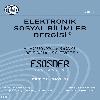Establishment of the british protectorate ın northern mesopotamıa during the end of world warı /the great war
Birinci dünya savaşı sonrası dönemde kuzey mezopotamya da ingiliz himayesinin kurulması
___
- Monographies
- Al-Jumaily, Qassam, Irak ve Kemalizm Hareketi (19191923). Ankara: Atatürk Araştırma Merkezi 1999.
- Bell, Florance (ed.), The Letters of Gertrude Bell, II. London: Ernest Benn, 1927.
- Bell, Gertrude L., The Arab of Mesopotamia , Basra, 1917.
- Busch, Briton C., Britain, India and the Arabs (19141921). Los Angeles: University of California Press, 1971.
- Busch, Briton C., Mudros to Lausanne: Britains Frontier in West Asia, 1918-1923. Albany: State University of New York Press, 1976.
- Eagleton, Clyde, International Government. New York: The Ranold Press, 1957.
- Edmonds, Cecil J., Kurds, Turks and Arabs: Politics, Travel and Research in North-Eastern Iraq 1919-1925. London: Oxford University Press, 1957.
- Foster, Henry A., The Making of Modern Iraq: A Product of World Forces. London, Williams and Norgate, 1936.
- Hay, William R., Two Years in Kurdistan, Experiences of a Political Officer, 19181920. London: Sedgwick and Jackson, 1921.
- Helmreich, Paul C., From Paris to Sevres: The Partition of the Ottoman Empire at the Peace Conference of 19191920. Columbus: Ohio State University Press, 1974.
- Howard, Harry N., The Partition of Turkey: A Diplomatic History 19131923. New York: Howard Fertig, 1966.
- Hurewitz, Jacob C., Diplomacy in the Near and Middle East: A Documentary Record 19141956, II. New York: D. Van Nostrand, 1958.
- Kedourie, Elie, England and the Middle East. The Vital Years: 19141921. London: Bowes and Bowes, 1956.
- Longrigg, Stephen H., Iraq 1900 to 1950: A Political, Social and Economic History. Beirut: Oxford University Press, 1968.
- McDowall, David, A Modern History of the Kurds. London: I. B. Tauris, 1997.
- Nevakivi, Jukka, Britain, France and the Arab Middle East 1914-1920. London: Athone Press, 1963.
- New Age, xxxii (1923), 21314.
- Saral, Ahmet H., Türk İstiklâl Harbi , Güney Cephesi, IV. Ankara: Genelkurmay Başkanlığı Harp Tarihi Dairesi, 1966.
- Sluglett, Peter, Britain and Iraq, 19141932 . London: Ithaca Press, 1976.
- Smuts, Jan C., The League of Nations: A Practical Suggestion. London: Hodder and Stoughton, 1918.
- Stivers, William, Supremacy of Oil: Iraq, Turkey and the Anglo-American World Order, 19181930.
- London: Cornell University Press, 1982.
- Toynbee, Arnold J., Survey of International Affairs, 1925, The Islamic World, I. London: Humphrey Milford, 1927.
- Wilson, Arnold T., Mesopotamia, 19171920: A Clash of Loyalties. A Personal and Historical Record. London: Oxford University Press, 1931. Official Publications
- Documents on British Foreign Policy, 19191939, I/II. London: His Majestys Stationary Office, 1948.
- Documents on British Foreign Policy, 1919-1939, I/IV. London: Her Majestys Stationary Office, 1952.
- Documents on British Foreign Policy, 19191939, I/VIII. London: Her Majestys Stationary Office, 1958.
- Great Britain, Colonial Office, Report on Iraq Administration, October 1920 to March 1922. London: His Majestys Stationary Office, 1922.
- Great Britain, Colonial Office, Report on Iraq Administration, April 1922 to March 1923. London: His Majestys Stationary Office, 1923.
- Lozan Telgrafları Türk Diplomatik Belgelerinde Lozan Barış Konferansı, Şubat-Ağustos 1923, II. Ankara: Türk Tarih Kurumu, 1990.
- Review of the civil administration of Mesopotamia compiled by Miss Gertrude L. Bell for the acting civil commissioner, Parliamentary Papers, Cmd. 1061 (1920).
- Türkiye Büyük Millet Meclisi Gizli Celse Zabıtları, (Turkish National Assembly minutes of the secret sessions), I. Ankara: Türkiye Büyük Millet Meclisi Basımevi, 1980.
- Archival Materials
- Başbakanlık Osmanlı Arşivi (Prime-ministry Ottoman Archives), Dâhiliye Nezâreti Kalem-i Mahsusu (Interior Ministry Secretariat), 50-3/25, 53-3/65.
- British Library, India Office Records, Political and Secret Department Records 1756-c1950, 10/781, 10/782, 10/818.
- Dār al-Kutub wa al-Wathā'iq al-'Irāqiyyah (Iraq National Library and Archives), 808-t/4/1, 208- S.65/16/6.
- United Kingdom National Archives, Public Record Office, Air Force Papers, 20/512, 20/513.
- United Kingdom National Archives, Public Record Office, Cabinet Office Papers, 27/1, 27/24.
- United Kingdom National Archives, Public Record Office, Foreign Office Papers, 371/3384, 3385, 3407, 4149, 4156, 4161, 4191, 4192, 4193, 5048, 5068, 5069, 5227, 5228, 5229, 5230, 5231, 5232, 6346, 6347, 7772, 7781, 9004, 9009, 10824, 11458.
- United Kingdom National Archives, Public Record Office, Foreign Office Papers, 608/95/365.
- United Kingdom National Archives, Public Record Office, Foreign Office Papers, PRO 30/52/104.
- Yayın Aralığı: 4
- Yayıncı: Cahit AYDEMİR
Erken dönem İslam tarihinde merkez-çevre çatışması
Öğrenci devamsızlıklarının eğitim denetmenlerinin görüşlerine göre değerlendirilmesi
Mehmet Nuri GÖMLEKSİZ, Faysal ÖZDAŞ
Meslek liselerinde Türk dili ve edebiyatı eğitimi: Bir durum çalışması
Moodle uzaktan eğitim yönetim sisteminin çeviri dersine uygulaması
Ciro ve personel devir hızı ilişkisi
Zeki YÜKSEKBİLGİLİ, Oğuz ERDOĞAN, Gülbeniz AKDUMAN
İbrahim Hakan KARATAŞ, Ömer Faruk SÖZCÜ
Kobi'lerde araştırma ve geliştirmenin verimliliğe etkisi ve bir uygulama
